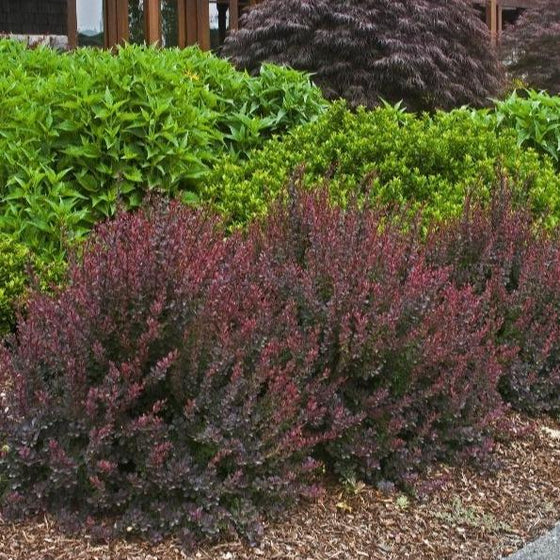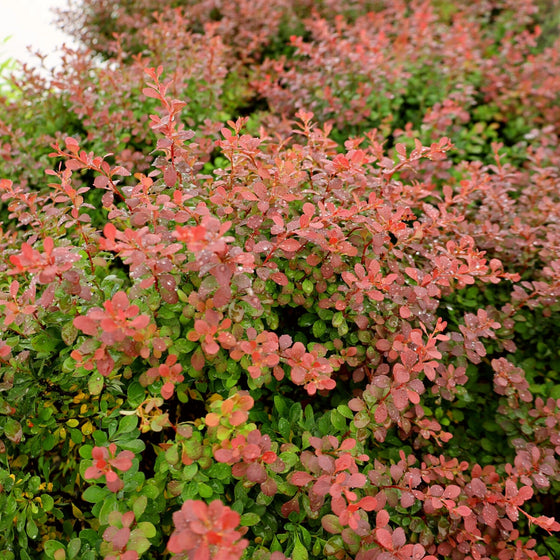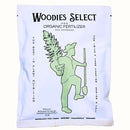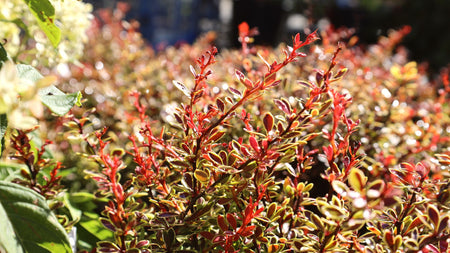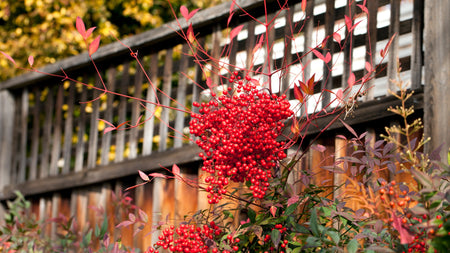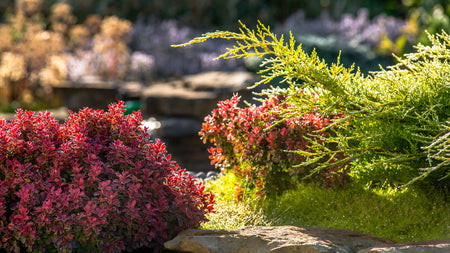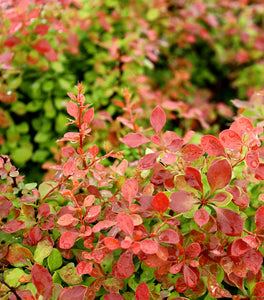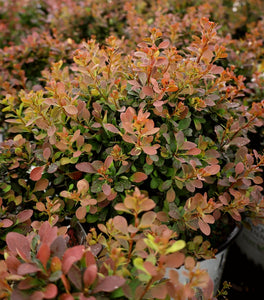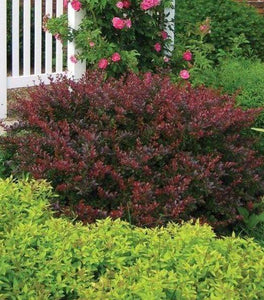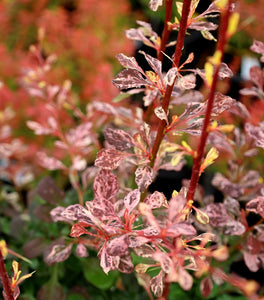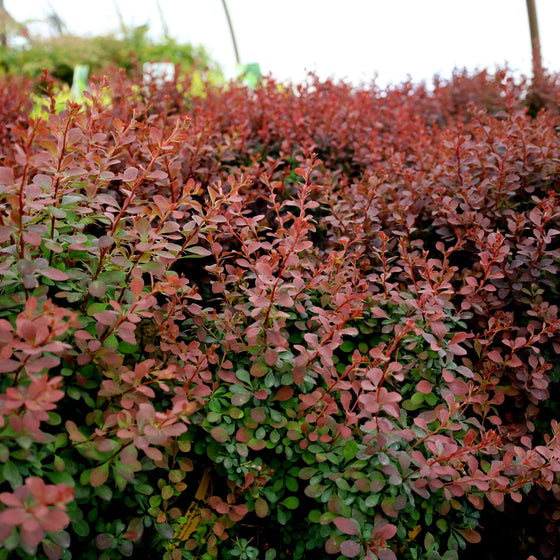
Images Depict Mature Plants
Royal Burgundy Barberry Shrub
Royal Burgundy Barberry (Berberis thunbergii 'Gentry') is a striking deciduous shrub known for its rich burgundy-purple foliage that adds bold, dramatic color to any landscape. This compact barberry grows to about 2 to 3 feet tall and wide, making it a perfect choice for small garden spaces, low hedges, and colorful borders. Throughout the growing season, its dense, mounded form is covered in vibrant leaves that intensify in color, creating eye-catching contrast against green and lighter-colored plants. In fall, Royal Burgundy Barberry offers additional interest as its foliage deepens into brilliant red tones before dropping for the winter.
Thriving in full sun and well-drained soil, Royal Burgundy Barberry is highly adaptable and low maintenance, showing excellent drought tolerance once established. It is also highly deer resistant, making it a reliable option for gardens where browsing animals can be a problem. Its thorny stems provide a natural deterrent against unwanted foot traffic, making it useful for planting under windows, along property lines, or in defensive landscape designs. This hardy barberry is also resistant to most pests and diseases, offering year-round beauty with minimal upkeep required.
Whether you use it as a colorful foundation plant, an accent in mixed shrub borders, or a bold edging along walkways, Royal Burgundy Barberry delivers dramatic color and texture to any sunny landscape. Its compact size, vibrant foliage, and rugged nature make it a top choice for gardeners looking to add easy-care, four-season interest. Plant Royal Burgundy Barberry in your garden to enjoy stunning color, natural structure, and enduring landscape appeal year after year.
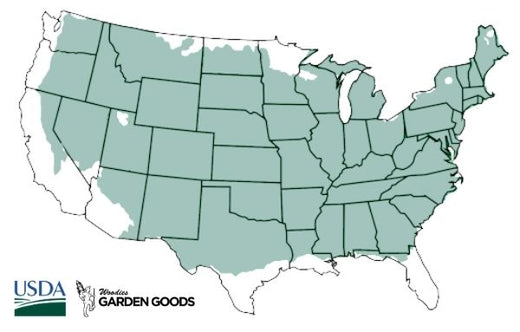
| Hardiness Zone: | 4-9 |
|---|---|
| Mature Height: | 3 feet |
| Mature Width: | 2 to 3 feet |
| Classification: | Broad Leaved deciduous shrub |
| Sunlight: | full sun to partial shade |
| Habit: | Columnar |
| Flower Color: | inconspicuous |
| Foliage: | orange-coral new growth, green at maturity, ruby red in Autumn |
| Soil Condition: | Any well drained soil |
| Water Requirements: | Water well until established. |
| Uses: | Use as a vertical feature or to add color to the mixed border. |
How to Care for Royal Burgundy Barberry
Be sure to read our planting instructions to ensure a healthy and happy Royal Burgundy Barberry Shrub plant for years to come!
How Do I Plant My Royal Burgundy Barberry Shrubs?
To plant your Royal Burgundy Barberry Shrubs successfully, choose a location that receives full sun to ensure the richest burgundy foliage color throughout the season. Begin by digging a hole twice as wide and just as deep as the shrub’s root ball to allow plenty of room for root expansion. Gently remove the shrub from its container, loosen any circling roots, and place it in the hole so that the top of the root ball sits level with the surrounding soil. Backfill with a blend of native soil and organic compost to improve drainage and soil health, then water deeply to settle the soil around the roots. After planting, apply a 2–3 inch layer of organic mulch around the base of your Royal Burgundy Barberry, keeping the mulch a few inches away from the stems to prevent rot. Mulching helps retain soil moisture, suppress weed growth, and regulate soil temperature, giving your new shrub the best possible start. Water thoroughly once or twice a week during the first growing season until the plant is well established. With proper planting and early care, your Royal Burgundy Barberry Shrubs will thrive, providing vibrant, low-maintenance color and structure to your landscape for years to come.
How Do I Water My Royal Burgundy Barberry Shrubs?
Watering your Royal Burgundy Barberry Shrubs correctly is essential for establishing a strong root system and maintaining vibrant, healthy foliage. During the first growing season, water deeply once or twice a week, allowing the soil to dry slightly between waterings. Deep watering encourages the roots to grow downward, making the shrub more drought-tolerant over time. Always water at the base of the plant to ensure moisture reaches the root zone and to keep the dense burgundy foliage looking its best without promoting fungal diseases. Once established, Royal Burgundy Barberry Shrubs are highly drought tolerant and require minimal supplemental watering. During prolonged dry spells or periods of extreme heat, monitor the soil and water when the top 2–3 inches feel dry. Applying a 2–3 inch layer of mulch around the base helps conserve soil moisture, minimize temperature fluctuations, and reduce watering needs. With proper watering practices, your Royal Burgundy Barberry will continue to provide bold color, dense structure, and easy-care beauty in sunny borders, foundation plantings, and landscape accents.
How Do I Fertilize My Royal Burgundy Barberry Shrubs?
Fertilizing your Royal Burgundy Barberry Shrubs properly helps promote healthy growth, dense branching, and vibrant, richly colored foliage throughout the growing season. In early spring, as new growth begins to emerge, apply a balanced slow-release fertilizer such as a 10-10-10 formula around the drip line of the shrub. Be sure to keep the fertilizer a few inches away from the stems to avoid potential root burn. After applying, water thoroughly to help the nutrients penetrate the soil and reach the roots, giving your Royal Burgundy Barberry the boost it needs to thrive. For continued success, a light feeding in midsummer can help maintain lush foliage, especially in nutrient-poor soils. Avoid over-fertilizing, as excessive nutrients can encourage overly rapid growth that may diminish the shrub’s naturally compact form. Incorporating organic compost into the soil once a year can also enrich soil structure and support long-term plant health naturally. With proper fertilization, your Royal Burgundy Barberry Shrubs will deliver dense, colorful, and low-maintenance beauty, making them standout additions to sunny borders, foundation plantings, and defensive hedges.

How and When Do I Prune My Royal Burgundy Barberry Shrubs?
Pruning your Royal Burgundy Barberry Shrubs helps maintain their compact, mounded form and encourages dense, vibrant growth. The best time to prune is in late winter or early spring before new growth begins, allowing you to easily see the shrub’s natural structure. Start by removing any dead, damaged, or diseased branches using clean, sharp pruning shears. Thin out any crowded interior stems to improve air circulation and light penetration, which helps keep the rich burgundy foliage healthy and vibrant. Lightly shaping the outer edges will preserve the shrub’s naturally tidy appearance without compromising its dense, colorful form. If needed, you can also perform a light summer pruning after the first flush of growth to maintain a crisp, manicured look in more formal landscapes. Avoid heavy pruning late in the season, as it can stimulate tender new growth that may not harden off before winter. With consistent annual pruning, your Royal Burgundy Barberry Shrubs will remain thick, colorful, and well-shaped, making them perfect for use in low hedges, foundation plantings, and bold landscape accents where dramatic foliage color and easy-care beauty are desired.
Frequently Asked questions
Be sure to read our planting instructions to ensure a healthy and happy Royal Burgundy Barberry Shrubs for years to come!


